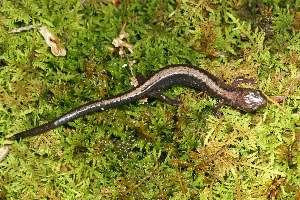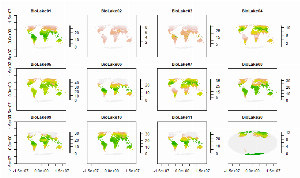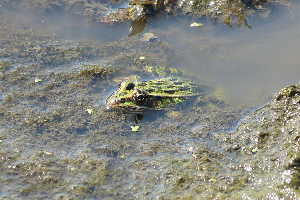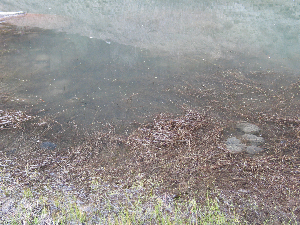Search ARMI Database
Search term(s)
Contribution Number
Search Results
20 record(s) found.
Data Release Mercury concentrations in amphibian tissues across the United States, 2016-2021
Authors: Colleen S Emery; Collin A Eagles-Smith; Kelly L Smalling; Blake R Hossack; Brian J Tornabene; Michael J Adams; Adam R Backlin; Adrianne B Brand; Robert N Fisher; Jill Fleming; Brad M Glorioso; Daniel A Grear; Evan HC Grant; Brian J Halstead; Patrick M Kleeman; David AW Miller; Erin Muths; Christopher A Pearl; Jennifer C Rowe; Caitlin T Rumrill; Hardin J Waddle; Megan E Winzeler
Date: 2023-08-23
Comma-separated values (.csv) file containing data related to amphibian sampling across the United States between 2016 and 2021. Data files contain mercury concentrations in amphibian and dragonfly tissues, mercury concentrations in sediment, as well as amphibian morphometrics, and habitat and climate characteristics where the samples were collected.
Data Release Student Network for Amphibian Pathogen Surveillance Data: U.S. Geological Survey data release
Authors: Megan E Winzeler; Daniel A Grear
Date: 2023-05-16 | Outlet: USGS Science Base
Data in this dataset were collected as a part of the Student Network for Amphibian Pathogen Surveilance (SNAPs) program throughout the United States by undergraduate students in biology or ecology courses as a part of their curriculum throughout 2022. This data was collected in the field by students and sent to the USGS National Wildlife Health Center (NWHC) for testing of two amphibian fungal pathogens, Batrachochytrium dendrobatidis (Bd) and Batrachochytrium salamandrivorans (Bs). The dataset includes both the field records of the individual amphibians tested and the results for individuals for Bd and Bsal
Data Release Data release - Abiotic and biotic factors reduce viability of a high-elevation salamander in its native range
Authors: Evan HC Grant; Graziella V DiRenzo; Adrianne B Brand
Date: 2023-04-11 | Outlet: ScienceBase
Includes data used to estimate population demographic parameters for an exemplary high-elevation amphibian species, the federally endangered Shenandoah salamander (Plethodon shenandoah). These parameters were entered into a Markov projection model which we used to forecast the future population status of the Shenandoah salamander.
Data Release Student Network for Amphibian Pathogen Surveillance Data: U.S. Geological Survey data release
Authors: Megan E Winzeler; Daniel A Grear
Date: 2023-05-08 | Outlet: USGS Science Base
Data in this dataset were collected as a part of the Student Network for Amphibian Pathogen Surveilance (SNAPs) program throughout the United States by undergraduate students in biology or ecology courses as a part of their curriculum2020-2022. This data was collected in the field by students and sent to the USGS National Wildlife Health Center (NWHC) for testing of two amphibian fungal pathogens, Batrachochytrium dendrobatidis (Bd) and Batrachochytrium salamandrivorans (Bsal).
Data Release Calculations of BioLake climate data
Authors: Ryan C Burner; Richard E Erickson
Date: 2022-11-01 | Outlet: USGS GitLab
Climate data allow people to examine species distributions and possible distributions. This script takes ERA5-Land climate estimates (https://www.ecmwf.int/en/forecasts/datasets/reanalysis-datasets/era5) for precipitation and lake temperature and processes them to create summary climate layers for use with biological organisms in lakes. This code could be modified to use a different subset of years.
These BioLake raster data provide global estimates (~10.0 x 12.4 km resolution) of twelve bioclimatic variables based on estimated lake temperature. Eleven of these twelve variables (BioLake01 - BioLake11) are estimated for each of three lake strata: lake mix (surface) layer, lake bottom, and total lake water column. These eleven variables correspond to CHELSA (Climatologies at high resolution for the earth's land surface areas) bioclimatic variables BIO1 - BIO11, except that these BioLake variables are based on lake water temperature and CHELSA BIO1 - BIO11 variables are based on air temperature. CHELSA BIO is also calculated a finer spatial resolution (~1 x 1 km). The twelfth variable (BioLake20; months with non-zero ice cover) does not correspond to any CHELSA bioclimatic variable. The data are supplied as a multi-layer raster (.grd) file in the World Mollweide projection, accompanied by a header file (.gri) with layer names.
For BioLake layer download, see https://doi.org/10.5066/P96QLN5Y
These BioLake raster data provide global estimates (~10.0 x 12.4 km resolution) of twelve bioclimatic variables based on estimated lake temperature. Eleven of these twelve variables (BioLake01 - BioLake11) are estimated for each of three lake strata: lake mix (surface) layer, lake bottom, and total lake water column. These eleven variables correspond to CHELSA (Climatologies at high resolution for the earth's land surface areas) bioclimatic variables BIO1 - BIO11, except that these BioLake variables are based on lake water temperature and CHELSA BIO1 - BIO11 variables are based on air temperature. CHELSA BIO is also calculated a finer spatial resolution (~1 x 1 km). The twelfth variable (BioLake20; months with non-zero ice cover) does not correspond to any CHELSA bioclimatic variable. The data are supplied as a multi-layer raster (.grd) file in the World Mollweide projection, accompanied by a header file (.gri) with layer names.
For BioLake layer download, see https://doi.org/10.5066/P96QLN5Y
Data Release BioLake bioclimatic variables based on ERA5-Land lake temperature estimates 1991-2020
Authors: Ryan C Burner; Richard E Erickson
Date: 2022-01-21 | Outlet: USGS ScienceBase
These BioLake raster data provide global estimates (~10.0 x 12.4 km resolution) of twelve bioclimatic variables based on estimated lake temperature. Eleven of these twelve variables (BioLake01 - BioLake11) are estimated for each of three lake strata: lake mix (surface) layer, lake bottom, and total lake water column. These eleven variables correspond to CHELSA (Climatologies at high resolution for the earth's land surface areas) bioclimatic variables BIO1 - BIO11, except that these BioLake variables are based on lake water temperature and CHELSA BIO1 - BIO11 variables are based on air temperature. CHELSA BIO is also calculated a finer spatial resolution (~1 x 1 km). The twelfth variable (BioLake20; months with non-zero ice cover) does not correspond to any CHELSA bioclimatic variable. The data are supplied as a multi-layer raster (.grd) file in the World Mollweide projection, accompanied by a header file (.gri) with layer names.
Data Release Survival and sublethal effects of amphibians exposed to NaCl and brines from energy production
Authors: Brian J Tornabene; Creagh W Breuner; Blake R Hossack
Date: 2019-06-25 | Outlet: PANGAEA Data Publisher for Earth & Environmental Science
We investigated the influence of brines and NaCl alone at commensurate concentrations on three larval amphibian species that occur in areas with energy-related brine contamination. The dataset contains size information (mass in grams, snout-vent length in millimeters) of larval Boreal Chorus Frogs (Pseudacris maculata) and Leopard Frogs (Rana pipiens) and Barred Tiger Salamanders (Ambystoma mavortium) taken during 96-h lethal-concentration-50 experiments. Larvae were generally exposed to concentrations of brine or NaCl ranging from 0–8,000 mg/L increasing by 1,000 mg/L increments. Other associated dataset: https://doi.pangaea.de/10.1594/PANGAEA.913836
Data Release Corticosterone Mediates Lethal and Sublethal Effects and a Growth-Survival Tradeoff for a Larval Amphibian Exposed to Increased Salinity
Authors: Brian J Tornabene; Blake R Hossack; E J Crespi; Creagh W Breuner
Date: 2018-11-06 | Outlet: PANGAEA Data Publisher for Earth & Environmental Science
We investigated the influence of increased salinity on survival, growth, water content, and Corticosterone responses of larval Northern Leopard Frogs (Rana pipiens) by exposing them to environmentally-relevant salinity treatments for 24 days. We also inhibited Corticosterone for half of the replicates using mifepristone to determine if Corticosterone mediates effects of salinity and tradeoffs between traits. Other associated datasets:
https://doi.pangaea.de/10.1594/PANGAEA.919212
https://doi.pangaea.de/10.1594/PANGAEA.919211
https://doi.pangaea.de/10.1594/PANGAEA.919209
https://doi.pangaea.de/10.1594/PANGAEA.919212
https://doi.pangaea.de/10.1594/PANGAEA.919211
https://doi.pangaea.de/10.1594/PANGAEA.919209
Data Release Hatching success, survival, size and development, and behavioral data for two amphibian species exposed to NaCl and energy-related saline wastewaters
Authors: Brian J Tornabene; Creagh W Breuner; Blake R Hossack
Date: 2021-09-24 | Outlet: figshare
We investigated the relative effects of NaCl and energy-related saline wastewaters on hatching success, survival, size and development, and behaviors of northern leopard frogs ([i]Rana pipiens[/i]) and boreal chorus frogs ([i]Pseudacris maculata[/i]). Eggs were exposed and responses were tracked through hatching for 24 days. Five datasets are included. (1) Includes hatching and survival data for leopard frog eggs and larvae. (2) Includes hatching and survival data for chorus frog eggs and larvae. (3) Includes behavioral responses of both species monitored daily from day 9–24. (4) Includes morphology measurements from larval leopard frogs taken at the end of the experiment on day 24. (5) Includes morphology measurements from larval leopard frogs taken at the end of the experiment on day 24.
Data Release Larval amphibian and site-water corticosterone, and site attributes, from wetlands affected by energy-related saline wastewaters
Authors: Brian J Tornabene; Blake R Hossack; E J Crespi; Creagh W Breuner
Date: 2021-09-24 | Outlet: figshare
We investigated the influence of salinity from energy-related saline wastewaters on CORT of three larval amphibians (Tiger salamanders, Leopard frogs, and Chorus frogs) in Montana and North Dakota where wastewater contamination is pervasive. We measured baseline and stress-induced CORT (pg/h) of amphibians exposed to a gradient of wastewaters using a novel, noninvasive technique. We also measured background corticosterone in site water in 2017 and 2018, and evaluated variance within and among wetlands in 2019. Three datasets are included. (1) Includes corticosterone and morphology measurements from larval amphibians taken in 2017 and 2018. (2) Includes background corticosterone measurements and attributes from sites in 2017–2019. (3) Includes background corticosterone measurements for 5 points along the perimeter of 6 sites in 2019 to evaluate variance within and among wetlands.
Data Release Current use pesticides in larval amphibian tissues, amphibian pathogen and wetland sediment screening data from three northeastern National Wildlife Refuges, 2013-14
Authors: Kelly L Smalling; Adam Boehlke; L Iwanowicz; Michelle L Hladik; Keith A Loftin; R Femmer; Adrianne B Brand; Evan HC Grant
Date: 2021-11-04 | Outlet: U.S. Geological Survey Data Release
The data include concentrations of current use pesticides in tissues of larval wood frog (Lithobates sylvaticus) and spotted salamander (Ambystoma maculatum) and the presence of ranavirus in wood frogs and spotted salamanders from three northeastern National Wildlife Refuges sampled in 2013 and 2014. The data also include estrogenicity, protein phosphatase 2A inhibition and a suite of 15 major and minor elements in sediment screened using portable X-Ray Fluorescence. The data include sediment and tissue samples collected from 16 wetlands at the Patuxent Research Refuge (PRR) in central Maryland, USA, 15 wetlands at the Assabet River and Oxbow National Wildlife Refuges (EMASS) in eastern Massachusetts, USA, and nine wetlands at the Chesapeake and Ohio Canal National Historic Park (CHOH) near the border of Washington DC and Maryland, USA.
Data Release Metal concentrations in sediment and amphibian tissues from wetlands sampled across the United States
Authors: Kelly L Smalling
Date: 2021-05-09 | Outlet: US Geological Survey data release
Data Release Seasonal median daily water depths for study wetlands in the St. Croix National Scenic Riverway, the North Temperate Lakes Long-term Research area, and the Upper Mississippi River study area from 2013-2018
Authors: Walt J Sadinski; Mark F Roth
Date: 2020-05-20 | Outlet: U.S. Geological Survey data release, https://doi.org/10.5066/P9H4VLEM
To relate water levels in our study wetlands to temperature, precipitation, wetland water depth, and amphibian calling activity, we installed one pressure logger in the deepest spot we could find in each wetland. Soon after thawing conditions allowed, we drove a plastic pipe (anchor pipe) into the sediments at the deepest location and secured another pipe to it that contained one pressure logger (Onset Computer Corporation Model U20-001-04 [Bourne, MA, USA]) suspended approximately 2.5 cm above the sediments. We installed additional individual pressure loggers in the upper part of the logger pipes (in air) at select locations to measure barometric pressure for calibrating the submerged loggers’ readings. We measured pressure once per hour and used software supplied by the logger manufacturers to upload and convert data to depth at the end of each season.
Data Release Oregon spotted frog (Rana pretiosa) monitoring data for metademographic analysis 2010-2018, Oregon: U.S. Geological Survey Data Release
Authors: Jennifer C Rowe; Adam Duarte; James T Peterson; Christopher A Pearl; Brome McCreary; Stephanie K Galvan; Michael J Adams
Date: 2020-05-05 | Outlet: ScienceBase
This dataset contains information from surveys conducted 2010-2018 by USGS as part of a long-term Oregon spotted frog monitoring effort in the central Oregon range. Data consist of site, survey, habitat, and species detection covariates, as well as inter-site distance measurements.
Data Release Amphibian Occupancy and Effects of Habitat Use on Pesticide Exposure in Iowa Wetlands
Authors: J E Swanson,; Erin Muths; Clay L Pierce; M Vandever; Kelly L Smalling
Date: 2018-03-09 | Outlet: US Geological Survey Data Release
Amphibians living in agricultural areas encounter many challenges. Two factors affecting individuals in these landscapes are habitat loss and pesticides. This thesis focuses on amphibians using agricultural wetlands in Iowa, where row crops such as corn and soybeans dominate the landscape. The goal of of the first study was to determine the influences of site characteristics on amphibian presence and success. Occupancy analysis was used to estimate proportion of area occupied by four species as a function of eight covariates hypothesized to affect occupancy: fish abundance, salamander abundance, invertebrate density, vegetative cover, wetland area, water atrazine concentration, surrounding crop land use, and overall wetland health score. We surveyed 27 wetlands in 2015 and 2016. Occupancy analysis results indicate almost all covariates were supported in our model sets although their estimated effects were weak. Direction of predicted effects of covariates on amphibians varied by species and life stage. Results show that wetland site occupancy for species in our study ranged from https://0.23 to https://0.95. Although we did not find strong evidence that the environmental factors we measured influenced amphibian occupancy, we provide insight on amphibian use of a modified agricultural landscape. The goal of the second study was to understand where and when frogs are most susceptible to pesticide exposure and how that exposure relates to accumulation. We hypothesized habitat use would influence a frog’s exposure to pesticides. We radio tracked 72 Northern Leopard Frogs (Lithobates pipiens) in agricultural wetlands and assessed their survival. We used Passive Sampling Devices (PSDs) to test for differences in pesticide exposure among grassland, wetland, and agricultural habitats. We found that pesticide concentration analyzed from PSDs varied among habitat types (P < 0.01) with concentration greatest in agricultural habitats. Amphibians frequently used wetland habitats early in our study, and transitioned into grassland habitats later in the summer, using agricultural fields rarely. Number and concentration of pesticides were greatest in tissues collected in May, but few pesticides were detected in individuals captured in August (P < https://0.01 and P < https://0.01, respectively). Our results indicate risk of pesticide accumulation is highest in aquatic habitats earlier in the year.
Data Release Water quality data from the Goose Lake Study Site Eastern Montana 1989-2018: U.S. Geological Survey data release.
Authors: Todd Preston
Date: 2019
Data release for water quality information from the Goose Lake Study Site, northeastern Montana.
Data Release Annotated bibliography of grazing effects on amphibians and their habitats (ver. 2.0, February 2022)
Authors: Jennifer C Rowe; Christopher A Pearl; Michael J Adams; Brome McCreary
Date: 2022-02-10 | Outlet: Science Base
Livestock grazing is one of the most common land uses in the western United States, where multiple amphibians of conservation concern use habitats that are grazed. Despite the common intersection of grazing and sensitive amphibian species, there are very few reviews of research related to the issue. USGS researchers compiled and summarized literature pertaining to livestock grazing effects on amphibians and their habitats, with an emphasis on wetland-breeding species in the western United States. Users of the annotated bibliography can utilize an integrated search tool with user-defined criteria to query records and output results. This tool aids users in synthesizing research related to a range of specific questions and should assist land managers in evaluating and implementing grazing while maintaining habitat for wetland amphibians.
Data Release Long-term amphibian monitoring data from the Willamette Valley, Oregon (2004-2015): U.S. Geological Survey data release
Authors: Michael J Adams; Christopher A Pearl; Brome McCreary; Stephanie K Galvan; Jennifer C Rowe; Adam Duarte; James T Peterson
Date: 2019-03-28 | Outlet: ScienceBase
This dataset contains information from surveys conducted 2004-2015 by USGS as part of a long-term amphibian monitoring effort in the Willamette Valley, Oregon. Data consist of site, survey, habitat, and species detection covariates.
Data Release Terrestrial salamander captures after the 2003 Clark Fire, Willamette National Forest, OR: U.S. Geological Survey data release
Authors: Nathan D Chelgren; Michael J Adams; Brome McCreary; Christopher A Pearl; Jennifer C Rowe
Date: 2019-05-21 | Outlet: ScienceBase
Data are the result of fixed-area, time-constrained searches for terrestrial salamanders within and nearby a wildfire-affected area of the Willamette National Forest, OR. The spatial extent of the study was within one kilometer of the border of the Clark fire that burned an area of 2,009 ha in 2003. Site surveys occurred during March and April, 2005. An important feature of the data is that 100m2 sub-plots (nested within plots) were repeatedly searched for terrestrial salamanders independently up to nine times so that variation in the probability of capture could be estimated and accounted for concurrent with estimates of occupancy probability.
Data Release Columbia Spotted Frog (Rana luteiventris) Breeding at Grazing Exclosures in Eastern Oregon 2002-2010 and 2013: U.S. Geological Survey data release
Authors: Michael J Adams; Christopher A Pearl; Brome McCreary; Stephanie K Galvan; Jennifer C Rowe
Date: 2018-02-01 | Outlet: ScienceBase
We studied the short-term effects of full and partial livestock grazing exclosures on Columbia Spotted Frog (CSF; Rana luteiventris) populations using a controlled manipulative field experiment with pre- and post-treatment data. This dataset includes vegetation data collected 2002-2010 and 2013 at 94 lakes and ponds in and around the Blue Mountains in eastern Oregon. Data collection followed standardized survey protocols and included annual oviposition surveys and vegetation surveys. These data allowed for quantification of CSF breeding as related to vegetation within and outside of grazing exclosures at each site.




